technical data SKODA OCTAVIA TOUR 2011 2.G / (1Z) Manual PDF
[x] Cancel search | Manufacturer: SKODA, Model Year: 2011, Model line: OCTAVIA TOUR, Model: SKODA OCTAVIA TOUR 2011 2.G / (1Z)Pages: 183, PDF Size: 11.13 MB
Page 138 of 183
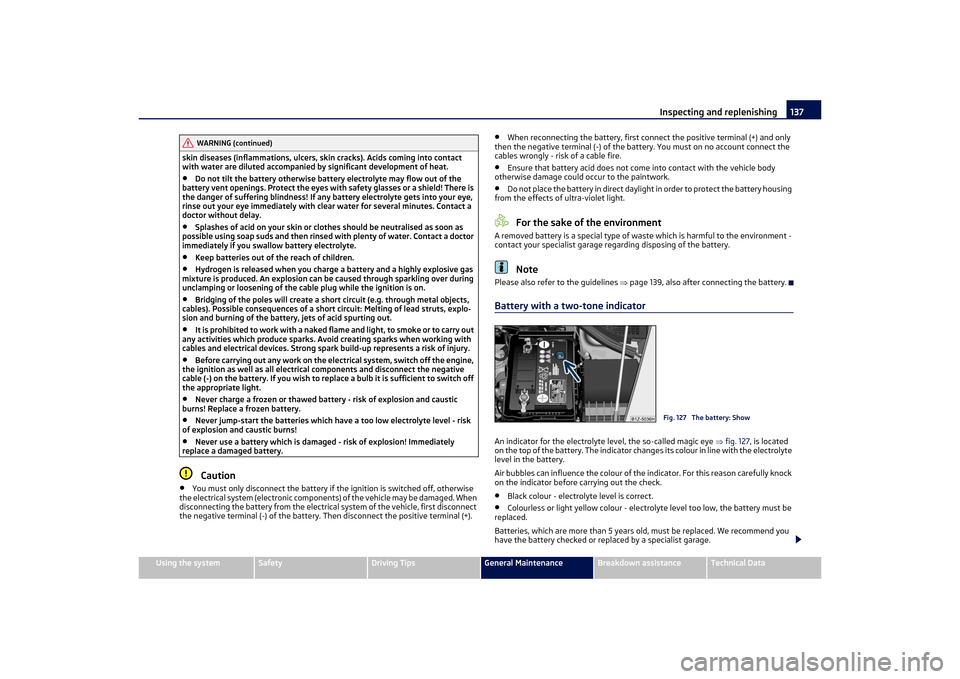
Inspecting and replenishing137
Using the system
Safety
Driving Tips
General Maintenance
Breakdown assistance
Technical Data
skin diseases (inflammations, ulcers, sk
in cracks). Acids coming into contact
with water are diluted accompanied by significant development of heat.
•
Do not tilt the battery otherwise batt ery electrolyte may flow out of the
battery vent openings. Protect the eyes wi th safety glasses or a shield! There is
the danger of suffering blindness! If any battery electrolyte gets into your eye,
rinse out your eye immediately with clear water for several minutes. Contact a
doctor without delay.
•
Splashes of acid on your skin or clot hes should be neutralised as soon as
possible using soap suds and then rinsed with plenty of water. Contact a doctor
immediately if you swal low battery electrolyte.
•
Keep batteries out of the reach of children.
•
Hydrogen is released when you charge a battery and a highly explosive gas
mixture is produced. An explosion can be caused through sparkling over during
unclamping or loosening of the cable plug while the ignition is on.
•
Bridging of the poles will create a short circuit (e.g. through metal objects,
cables). Possible consequences of a short circuit: Melting of lead struts, explo-
sion and burning of the battery, jets of acid spurting out.
•
It is prohibited to work with a naked fl ame and light, to smoke or to carry out
any activities which produce sparks. Avoid creating sparks when working with
cables and electrical devices. Strong spar k build-up represents a risk of injury.
•
Before carrying out any work on the electrical system, switch off the engine,
the ignition as well as all electrical components and disconnect the negative
cable (-) on the battery. If you wish to repl ace a bulb it is sufficient to switch off
the appropriate light.
•
Never charge a frozen or thawed batt ery - risk of explosion and caustic
burns! Replace a frozen battery.
•
Never jump-start the batteries which have a too low electrolyte level - risk
of explosion and caustic burns!
•
Never use a battery which is damaged - risk of explosion! Immediately
replace a damaged battery.Caution
•
You must only disconnect the battery if the ignition is switched off, otherwise
the electrical system (electronic componen ts) of the vehicle may be damaged. When
disconnecting the battery from the electrical system of the vehicle, first disconnect
the negative terminal (-) of the battery. Then disconnect the positive terminal (+).
•
When reconnecting the battery, first connect the positive terminal (+) and only
then the negative terminal (-) of the batt ery. You must on no account connect the
cables wrongly - risk of a cable fire.
•
Ensure that battery acid does not come into contact with the vehicle body
otherwise damage could occur to the paintwork.
•
Do not place the battery in direct daylight in order to protect the battery housing
from the effects of ultra-violet light.For the sake of the environment
A removed battery is a special type of wa ste which is harmful to the environment -
contact your specialist garage regarding disposing of the battery.
Note
Please also refer to the guidelines page 139, also after connecting the battery.Battery with a two-tone indicatorAn indicator for the electrolyte level, the so-called magic eye fig. 127, is located
on the top of the battery. The indicator changes its colour in line with the electrolyte
level in the battery.
Air bubbles can influence the colour of the indicator. For this reason carefully knock
on the indicator before carrying out the check.•
Black colour - electrolyte level is correct.
•
Colourless or light yellow colour - electrolyte level too low, the battery must be
replaced.
Batteries, which are more than 5 years ol d, must be replaced. We recommend you
have the battery checked or replaced by a specialist garage.
WARNING (continued)
Fig. 127 The battery: Show
s2lk.2.book Page 137 Monday, April 18, 2011 7:41 AM
Page 140 of 183

Inspecting and replenishing139
Using the system
Safety
Driving Tips
General Maintenance
Breakdown assistance
Technical Data
– Switch the ignition and all electrical components off.
– Only for “quick-charging”: Disconnect both battery cables (first of all “negative”,
then “positive”).
– Carefully attach the termin al clamps of the charger to the battery terminals (red
= “positive”, black = “negative”).
– You can now plug the mains cable of the charger into the power socket and
switch on the charger.
– When charging is completed: switch the charger off and unplug the mains cable from the power socket.
– Only then should you disconnect th e terminal clamps of the charger.
– Reconnect the cables to the battery (first of all “positive”, then “negative”).
It is not normally necessary to disconnect the cables of the battery if you recharge
the battery using low amperages (as for example from a mini-charger). Please also
refer to the instructions fr om the charger manufacturer.
A charging current of 0.1 of the total batter y capacity (or lower) is that which should
be used until full charging is achieved.
It is, however, necessary to disconnect both cables before charging the battery with
high amperages, so-called “ quick-charging”.
“Quick-charging” a battery is dangerous in “Working on the battery” on
page 136. It requires a special charger and appropriate knowledge. We therefore
recommend that you have yo ur battery quick-charged only by your Škoda Service
Partner.
A discharged battery may already freeze at temperatures just below 0 °C . We
recommend that you no longer use a battery which has thawed out because the
casing of the battery may be cracked thro ugh the formation of ice and this would
allow battery electrolyte to flow out.
The vent plugs of the battery should not be opened for charging.
WARNING
•
Never charge a frozen or thawed batt ery - risk of explosion and caustic
burns. Replace a frozen battery.
•
Never charge a battery which has a too low electrolyte level - risk of explo-
sion and caustic burns.
Disconnecting and reconnecting the batteryOn disconnecting and reconnecting the batt ery the following functions are initially
deactivated or are no longer able to operate fault-free.
We recommend having the vehicle checked by a Škoda Service Partner to ensure
full functionality of all electrical systems.Replacing the batteryYou should only replace a battery with a new battery of the same capacity, voltage
(12 V), amperage and of the same size. Škoda Service Partners have a range of suit-
able batteries available.
We recommend that you only have an old battery disposed of by your Škoda Service
Partner since it does require special disposal.
For the sake of the environment
Batteries contain poisonous substances such as sulphuric acid and lead. They must
be disposed of in accordance with loca l environmental protection regulations and
on no account as domestic waste.•
I n v i e w o f t h e p r o b l e m s i n v o l v e d w i t h i t s p r o p e r d i s p o s a l , w e r e c o m m e n d h a v i n g
the battery replaced by a specialist garage.Operation
Operating measure
Electrical power window (operational faults)
page 39
Enter radio code number
see Radio Operating Instructions
Set hours
page 17
Data in the multi-functional indicator* are
deleted.
page 18
s2lk.2.book Page 139 Monday, April 18, 2011 7:41 AM
Page 142 of 183
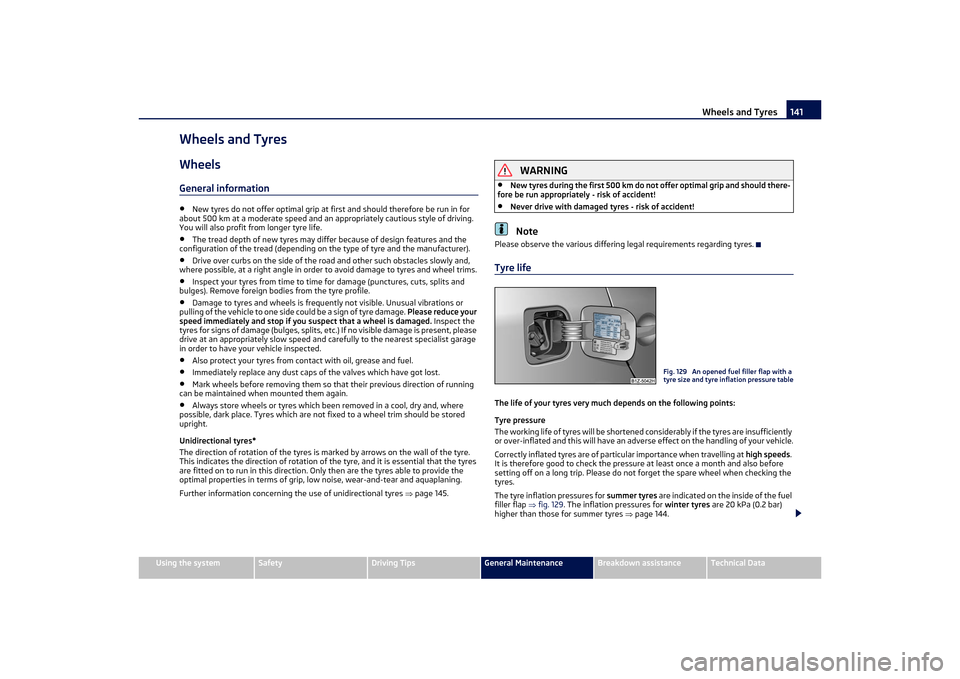
Wheels and Tyres141
Using the system
Safety
Driving Tips
General Maintenance
Breakdown assistance
Technical Data
Wheels and TyresWheelsGeneral information•
New tyres do not offer optimal grip at fi rst and should therefore be run in for
about 500 km at a moderate speed and an appropriately cautious style of driving.
You will also profit from longer tyre life.
•
The tread depth of new tyres may differ because of design features and the
configuration of the tread (depending on the type of tyre and the manufacturer).
•
Drive over curbs on the side of the road and other such obstacles slowly and,
where possible, at a right angle in order to avoid damage to tyres and wheel trims.
•
Inspect your tyres from ti me to time for damage (punctures, cuts, splits and
bulges). Remove foreign bodies from the tyre profile.
•
Damage to tyres and wheels is frequently not visible. Unusual vibrations or
pulling of the vehicle to one side could be a sign of tyre damage. Please reduce your
speed immediately and stop if you suspect that a wheel is damaged. Inspect the
tyres for signs of damage (bulges, splits, etc.) If no visible damage is present, please
drive at an appropriately slow speed and ca refully to the nearest specialist garage
in order to have your vehicle inspected.
•
Also protect your tyres from contact with oil, grease and fuel.
•
Immediately replace any dust caps of the valves which have got lost.
•
Mark wheels before removing them so that their previous direction of running
can be maintained when mounted them again.
•
Always store wheels or tyres which been removed in a cool, dry and, where
possible, dark place. Tyres which are not fixed to a wheel trim should be stored
upright.
Unidirectional tyres*
The direction of rotation of the tyres is marked by arrows on the wall of the tyre.
This indicates the direction of rotation of the tyre, and it is essential that the tyres
are fitted on to run in this direction. Only then are the tyres able to provide the
optimal properties in terms of grip, lo w noise, wear-and-tear and aquaplaning.
Further information concerning the use of unidirectional tyres page 145.
WARNING
•
New tyres during the first 500 km do not offer optimal grip and should there-
fore be run appropriatel y - risk of accident!
•
Never drive with damaged tyres - risk of accident!Note
Please observe the various differing legal requirements regarding tyres.Tyre lifeThe life of your tyres very much depends on the following points:
Tyre pressure
The working life of tyres will be shortened considerably if the tyres are insufficiently
or over-inflated and this will have an adverse effect on the handling of your vehicle.
Correctly inflated tyres are of partic ular importance when travelling at high speeds.
It is therefore good to check the pressure at least once a month and also before
setting off on a long trip. Please do not forget the spare wheel when checking the
tyres.
The tyre inflation pressures for summer tyres are indicated on the inside of the fuel
filler flap fig. 129 . The inflation pressures for winter tyres are 20 kPa (0.2 bar)
higher than those for summer tyres page 144.
Fig. 129 An opened fuel filler flap with a
tyre size and tyre inflation pressure table
s2lk.2.book Page 141 Monday, April 18, 2011 7:41 AM
Page 144 of 183
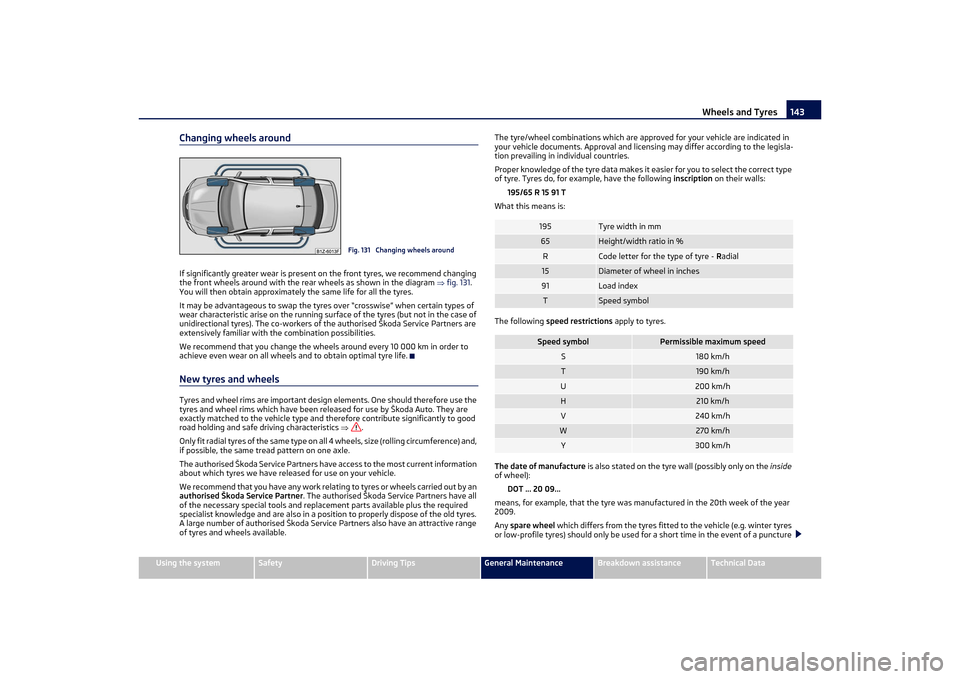
Wheels and Tyres143
Using the system
Safety
Driving Tips
General Maintenance
Breakdown assistance
Technical Data
Changing wheels aroundIf significantly greater wear is present on the front tyres, we recommend changing
the front wheels around with the rear wheels as shown in the diagram fig. 131.
You will then obtain approximately the same life for all the tyres.
It may be advantageous to swap the tyres over “crosswise” when certain types of
wear characteristic arise on the running surface of the tyres (but not in the case of
unidirectional tyres). The co -workers of the authorised Škoda Service Partners are
extensively familiar with the combination possibilities.
We recommend that you change the wheels around every 10 000 km in order to
achieve even wear on all wheels and to obtain optimal tyre life.New tyres and wheelsTyres and wheel rims are important design elements. One should therefore use the
tyres and wheel rims which have been released for use by Škoda Auto. They are
exactly matched to the vehicle type and th erefore contribute significantly to good
road holding and safe driving characteristics .
Only fit radial tyres of the same type on all 4 wheels, size (rolling circumference) and,
if possible, the same tr ead pattern on one axle.
The authorised Škoda Service Partners have access to the most current information
about which tyres we have released for use on your vehicle.
We recommend that you have any work relating to tyres or wheels carried out by an
authorised Škoda Service Partner . The authorised Škoda Service Partners have all
of the necessary special tools and replac ement parts available plus the required
specialist knowledge and are al so in a position to properly dispose of the old tyres.
A large number of authorised Škoda Service Partners also have an attractive range
of tyres and wheels available. The tyre/wheel combinations which are approved for your vehicle are indicated in
your vehicle documents. Approval and licensing may differ according to the legisla-
tion prevailing in individual countries.
Proper knowledge of the tyre data makes it easier for you to select the correct type
of tyre. Tyres do, for example, have the following
inscription on their walls:
195/65 R 15 91 T
What this means is:
The following speed restrictions apply to tyres.
The date of manufacture is also stated on the tyre wall (possibly only on the inside
of wheel):
DOT ... 20 09...
means, for example, that the tyre was manufactured in the 20th week of the year
2009.
Any spare wheel which differs from the tyres fitted to the vehicle (e.g. winter tyres
or low-profile tyres) should only be used for a short time in the event of a puncture
Fig. 131 Changing wheels around
195
Tyre width in mm
65
Height/width ratio in %
R
Code letter for the type of tyre - Radial
15
Diameter of wheel in inches
91
Load index
T
Speed symbol
Speed symbol
Permissible maximum speed
S
180 km/h
T
190 km/h
U
200 km/h
H
210 km/h
V
240 km/h
W
270 km/h
Y
300 km/h
s2lk.2.book Page 143 Monday, April 18, 2011 7:41 AM
Page 146 of 183
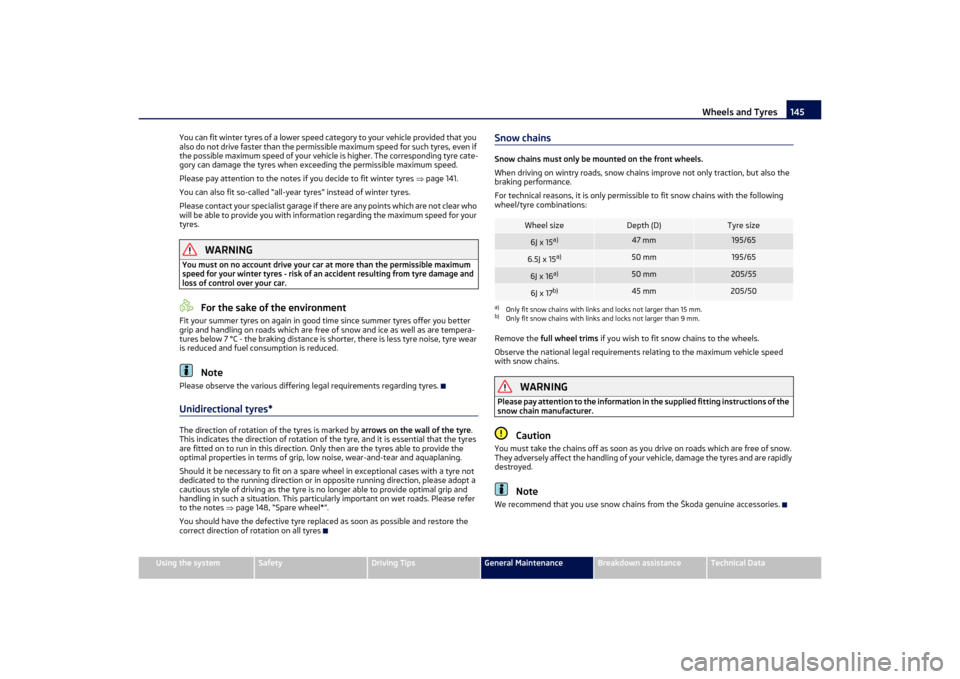
Wheels and Tyres145
Using the system
Safety
Driving Tips
General Maintenance
Breakdown assistance
Technical Data
You can fit winter tyres of a lower speed category to your vehicle provided that you
also do not drive faster than the permissible maximum speed for such tyres, even if
the possible maximum speed of your vehicle is higher. The corresponding tyre cate-
gory can damage the tyres when exceeding the permissible maximum speed.
Please pay attention to the notes if
you decide to fit winter tyres page 141.
You can also fit so-called “all-yea r tyres” instead of winter tyres.
Please contact your specialist garage if there are any points which are not clear who
will be able to provide you with information regarding the maximum speed for your
tyres.
WARNING
You must on no account drive your car at more than the permissible maximum
speed for your winter tyres - risk of an accident resulting from tyre damage and
loss of control over your car.
For the sake of the environment
Fit your summer tyres on ag ain in good time since summer tyres offer you better
grip and handling on roads which are free of snow and ice as well as are tempera-
tures below 7 °C - the braking distance is shor ter, there is less tyre noise, tyre wear
is reduced and fuel consumption is reduced.
Note
Please observe the various differing legal requirements regarding tyres.Unidirectional tyres*The direction of rotation of the tyres is marked by arrows on the wall of the tyre .
This indicates the direction of rotation of the tyre, and it is essential that the tyres
are fitted on to run in this direction. Only then are the tyres able to provide the
optimal properties in terms of grip, lo w noise, wear-and-tear and aquaplaning.
Should it be necessary to fit on a spare wheel in exceptional cases with a tyre not
dedicated to the running direction or in opposite running direction, please adopt a
cautious style of driving as the tyre is no longer able to provide optimal grip and
handling in such a situation. This particularly important on wet roads. Please refer
to the notes page 148, “Spare wheel*”.
You should have the defective tyre replaced as soon as possible and restore the
correct direction of rotation on all tyres
Snow chainsSnow chains must only be mounted on the front wheels.
When driving on wintry road s, snow chains improve not only traction, but also the
braking performance.
For technical reasons, it is only permissi ble to fit snow chains with the following
wheel/tyre combinations:
Remove the full wheel trims if you wish to fit snow chains to the wheels.
Observe the national legal requirements relating to the maximum vehicle speed
with snow chains.
WARNING
Please pay attention to the information in the supplied fitting instructions of the
snow chain manufacturer.
Caution
You must take the chains off as soon as you drive on roads which are free of snow.
They adversely affect the handling of your vehicle, damage the tyres and are rapidly
destroyed.
Note
We recommend that you use snow chains from the Škoda genuine accessories.
Wheel size
Depth (D)
Tyre size
6J x 15
a)
a)Only fit snow chains with links and locks not larger than 15 mm.
47 mm
195/65
6.5J x 15
a)
50 mm
195/65
6J x 16
a)
50 mm
205/55
6J x 17
b)
b)Only fit snow chains with links and locks not larger than 9 mm.
45 mm
205/50
s2lk.2.book Page 145 Monday, April 18, 2011 7:41 AM
Page 148 of 183
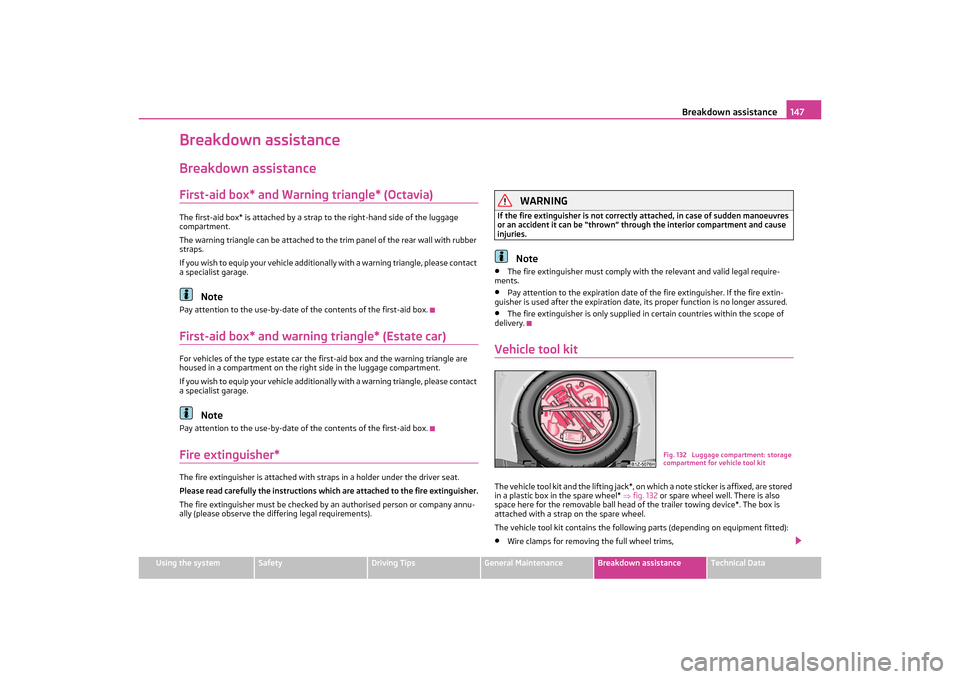
Breakdown assistance147
Using the system
Safety
Driving Tips
General Maintenance
Breakdown assistance
Technical Data
Breakdown assistanceBreakdown assistanceFirst-aid box* and Warning triangle* (Octavia)The first-aid box* is attached by a strap to the right-hand side of the luggage
compartment.
The warning triangle can be attached to the trim panel of the rear wall with rubber
straps.
If you wish to equip your vehicle additional ly with a warning triangle, please contact
a specialist garage.
Note
Pay attention to the use-by-date of the contents of the first-aid box.First-aid box* and warning triangle* (Estate car)For vehicles of the type estate car the first-aid box and the warning triangle are
housed in a compartment on the righ t side in the luggage compartment.
If you wish to equip your vehicle additional ly with a warning triangle, please contact
a specialist garage.
Note
Pay attention to the use-by-date of the contents of the first-aid box.Fire extinguisher*The fire extinguisher is attached with straps in a holder under the driver seat.
Please read carefully the in structions which are attached to the fire extinguisher.
The fire extinguisher must be checked by an authorised person or company annu-
ally (please observe the differing legal requirements).
WARNING
If the fire extinguisher is not correctly attached, in case of sudden manoeuvres
or an accident it can be “thrown” thro ugh the interior compartment and cause
injuries.
Note
•
The fire extinguisher must comply with the relevant and valid legal require-
ments.
•
Pay attention to the expiration date of the fire extinguisher. If the fire extin-
guisher is used after the expiration date, its proper function is no longer assured.
•
The fire extinguisher is only supplied in certain countries within the scope of
delivery.
Vehicle tool kitThe vehicle tool kit and the lift ing jack*, on which a note sticker is affixed, are stored
in a plastic box in the spare wheel* fig. 132 or spare wheel well. There is also
space here for the removable ball head of the trailer towing device*. The box is
attached with a strap on the spare wheel.
The vehicle tool kit contains the following parts (depending on equipment fitted):•
Wire clamps for removing the full wheel trims,
Fig. 132 Luggage compartment: storage
compartment for vehicle tool kit
s2lk.2.book Page 147 Monday, April 18, 2011 7:41 AM
Page 150 of 183
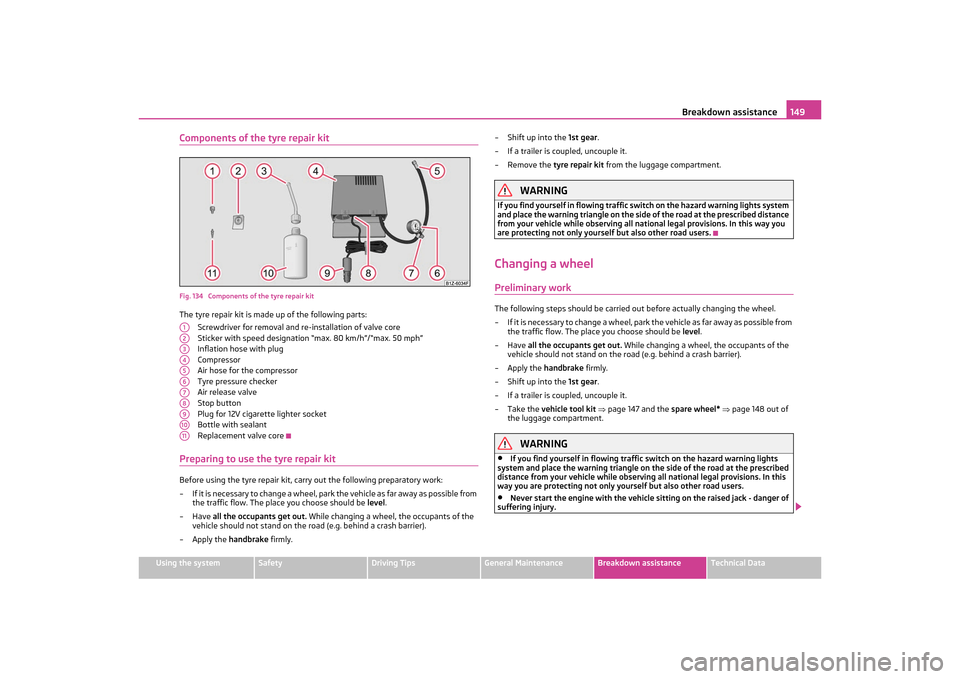
Breakdown assistance149
Using the system
Safety
Driving Tips
General Maintenance
Breakdown assistance
Technical Data
Components of the tyre repair kitFig. 134 Components of the tyre repair kitThe tyre repair kit is made up of the following parts:
Screwdriver for removal and re-installation of valve core
Sticker with speed designation “max. 80 km/h”/“max. 50 mph”
Inflation hose with plug
Compressor
Air hose for the compressor
Tyre pressure checker
Air release valve
Stop button
Plug for 12V cigarette lighter socket
Bottle with sealant
Replacement valve corePreparing to use the tyre repair kitBefore using the tyre repa ir kit, carry out the following preparatory work:
– If it is necessary to change a wheel, park the vehicle as far away as possible from
the traffic flow. The plac e you choose should be level .
–Have all the occupants get out. While changing a wheel, the occupants of the
vehicle should not stand on the ro ad (e.g. behind a crash barrier).
– Apply the handbrake firmly. – Shift up into the
1st gear.
– If a trailer is coup led, uncouple it.
– Remove the tyre repair kit from the luggage compartment.
WARNING
If you find yourself in flowing traffic sw itch on the hazard warning lights system
and place the warning triangle on the side of the road at the prescribed distance
from your vehicle while observing all nat ional legal provisions. In this way you
are protecting not only yourself but also other road users.Changing a wheelPreliminary workThe following steps should be carried ou t before actually changing the wheel.
– If it is necessary to change a wheel, park the vehicle as far away as possible from
the traffic flow. The place you choose should be level.
–Have all the occupants get out. While changing a wheel, the occupants of the
vehicle should not stand on the road (e.g. behind a crash barrier).
–Apply the handbrake firmly.
– Shift up into the 1st gear.
– If a trailer is coup led, uncouple it.
–Take the vehicle tool kit page 147 and the spare wheel* page 148 out of
the luggage compartment.
WARNING
•
If you find yourself in flowing traffi c switch on the hazard warning lights
system and place the warning triangle on the side of the road at the prescribed
distance from your vehicle while observin g all national legal provisions. In this
way you are protecting not only yourself but also other road users.
•
Never start the engine with the vehicle sitting on the raised jack - danger of
suffering injury.
A1A2A3A4A5A6A7A8A9A10A11
s2lk.2.book Page 149 Monday, April 18, 2011 7:41 AM
Page 152 of 183

Breakdown assistance151
Using the system
Safety
Driving Tips
General Maintenance
Breakdown assistance
Technical Data
•
Check for yourself that a safety wheel bolt is located in the hole in the area of
the valve before fitting the full wheel trim onto a steel wheel which is attached with
a safety wheel bolt page 152.
Wheel bolts with caps*Pulling off– Push the plastic clip sufficiently far on to the cap until the inner catches of the
clip are positioned at the collar of the cap and detach the cap.Installing– Push the caps fully onto the wheel bolts.
The caps are located in the well of the luggage compartment.Wheel trim caps*
Pulling off– Carefully remove the wheel trim cap using the wire clamp fig. 136 .Slackening and tightening wheel bolts
Slacken the wheel bolts before jacking up the vehicle.Slackening wheel bolts– Push the wheel wrench* fully onto the wheel bolt
7).
– Grasp the end of the wrench* and turn the bolt about one turn to the left
fig. 137.
Tightening wheel bolts– Push the wheel wrench* fully onto the wheel bolt
7).
– Grasp the end of the wrench* and turn th e bolt to the right until it is tight.
WARNING
Slacken the wheel bolts only a little (about one turn) as long as the vehicle has
not yet been lifted with the lifting jack* - risk of accident!
Note
Apply pressure carefully with your foot to the end of the wrench* if it proves difficult
to slacken the bolts. Hold tight on the vehicle when doing this and ensure that you
have a steady position.
Fig. 135 Removing the cap.Fig. 136 Pulling off wheel trim cap on
light alloy wheels
7)Use the appropriate adapter for slackening and tightening the safety wheel bolts page 152.
Fig. 137 Changing a wheel: Slackening
wheel bolts
s2lk.2.book Page 151 Monday, April 18, 2011 7:41 AM
Page 154 of 183

Breakdown assistance153
Using the system
Safety
Driving Tips
General Maintenance
Breakdown assistance
Technical Data
Note
The set of safety wheel bolts can be obta ined from an authorised Škoda Service
Partner.Jump-startingInitial stepsYou can use the battery of another vehicl e for jump-starting yours if the engine
does not start because the battery on your ve hicle is flat. You will require jump-start
cables for this purpose.
Both batteries must have a rated voltage of 12 V. The capacity (Ah) of the battery
supplying the power must not be signific antly less than the capacity of the
discharged battery in your vehicle.
Jump-start cables
Only use jump-start cables which have an adequately large cross-section and insu-
lated terminal clamps. Please pay attent ion to the manufacturer's instructions.
Positive cable - colour coding in the majority of cases red.
Negative cable - colour coding in the majority of cases black.
WARNING
•
A discharged battery may already freeze at temperatures just below 0 °C. In
case of frozen battery carry out no jump-starting - risk of explosion!
•
Please pay attention to the warning instructions relating to working in the
engine compartment page 131, “Working in the engine compartment”.Note
•
There must not be any contact between the two vehicles otherwise current may
flow as soon as the negati ve terminals are connected.
•
The discharged battery must be properly connected to the system of the
vehicle.
•
Switch off any mobile phone, pay attention to the instructions for use of the
mobile phone in such a situation.
•
We recommend you buy jump-start cables from a car battery specialist.
Start engineIt is important to connect the jump -start cables in the correct order.Connecting positive terminals– Attach one end to the positive terminal fig. 140 of the discharged battery
.
– Attach the other end to the positive terminal of the battery supplying the
power .Connecting negative terminal and engine block– Attach one end to the negative termin al of the battery supplying the power
.
– Attach the other end to a solid metal part which is connected firmly to the engine block, or to the engine block itself.Starting the engine– Start the engine of the vehicle providing current and run the engine at idling
speed.
– Now start the engine of the vehicle with the discharged battery.
– Interrupt the attempt at starting an engine after 10 seconds if it does not start right away and wait for about 30 seconds before repeating the attempt.
– Disconnect the cables on the engine in exactly the reverse order they were
connected up.
Fig. 140 Jump-starting using the battery
from another vehicle: A - flat vehicle
battery, B - battery providing current
1
A
2
B
3
B
4
s2lk.2.book Page 153 Monday, April 18, 2011 7:41 AM
Page 156 of 183

Breakdown assistance155
Using the system
Safety
Driving Tips
General Maintenance
Breakdown assistance
Technical Data
Front towing eye
The towing eye is stored in the box for the vehicle tool kit.Fig. 141 Front bumper: protective grille/installing the towing eyeRemove the protective grille carefully as follows:
– Press on grille with the hand (at the end removed from the licence plate) and
release it in the direction of the arrow fig. 141 - left.
– Screw in the towing eye by hand to the left up to the stop fig. 141 - right. For
tightening, we recommend that you use for example the wheel wrench*, the
towing eye of another vehicle or anothe r, similar object which you can push
through the eye.
– Put the protective grille in place after screwing out the towing eye again and press firmly into place. The protective grille must engage firmly.Rear towing eyeFig. 142 Rear bumper: Removing the cover/installing the towing eye
– Take the cover out of the rear bumper fig. 142 - left.
– Screw in the towing eye by hand to the left up to the stop fig. 142 - right. For
tightening, we recommend that you use for example the wheel wrench*, the
towing eye of another vehicle or anothe r, similar object which you can push
through the eye.
– Put the cover in place after screwing out the towing eye again and press into
place. The cover must engage firmly.
Caution
The towing eye must always be screwed in and tightened up to the stop. Otherwise
there is the risk of it coming loose when towing the vehicle, e.g. when tow-
starting.Towing the vehiclePlease refer to the notes page 154.
The vehicle can be towed in with a tow bar or a tow rope or with the front or rear
wheels raised. The maximum towing speed is 50 km/h.
s2lk.2.book Page 155 Monday, April 18, 2011 7:41 AM